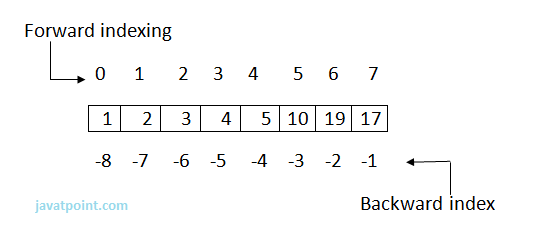|
91-9990449935 0120-4256464 |
Python TupleA tuple is a sequence of immutable objects, therefore tuple cannot be changed. The objects are enclosed within parenthesis and separated by comma. Tuple is similar to list. Only the difference is that list is enclosed between square bracket, tuple between parenthesis and List have mutable objects whereas Tuple have immutable objects. eg:
>>> data=(10,20,'ram',56.8)
>>> data2="a",10,20.9
>>> data
(10, 20, 'ram', 56.8)
>>> data2
('a', 10, 20.9)
>>>
NOTE: If Parenthesis is not given with a sequence, it is by default treated as Tuple. There can be an empty Tuple also which contains no object. eg: tuple1=() For a single valued tuple, there must be a comma at the end of the value. eg: Tuple1=(10,) Tuples can also be nested. eg: tupl1='a','mahesh',10.56 tupl2=tupl1,(10,20,30) print tupl1 print tupl2 Output:
>>>
('a', 'mahesh', 10.56)
(('a', 'mahesh', 10.56), (10, 20, 30))
>>>
Accessing TupleTuple can be accessed in the same way as List. Some examples are given below: eg:
data1=(1,2,3,4)
data2=('x','y','z')
print data1[0]
print data1[0:2]
print data2[-3:-1]
print data1[0:]
print data2[:2]
Output:
>>>
1
(1, 2)
('x', 'y')
(1, 2, 3, 4)
('x', 'y')
>>>
Elements in a TupleData=(1,2,3,4,5,10,19,17) 
Data[0]=1=Data[-8] , Data[1]=2=Data[-7] , Data[2]=3=Data[-6] , Data[3]=4=Data[-5] , Data[4]=5=Data[-4] , Data[5]=10=Data[-3], Data[6]=19=Data[-2],Data[7]=17=Data[-1] Tuple OperationsVarious Operations can be performed on Tuple. Operations performed on Tuple are given as: a) Adding Tuple:
Tuple can be added by using the concatenation operator(+) to join two tuples. eg:
data1=(1,2,3,4)
data2=('x','y','z')
data3=data1+data2
print data1
print data2
print data3
Output:
>>>
(1, 2, 3, 4)
('x', 'y', 'z')
(1, 2, 3, 4, 'x', 'y', 'z')
>>>
Note: The new sequence formed is a new Tuple. b) Replicating Tuple: Replicating means repeating. It can be performed by using '*' operator by a specific number of time. Eg: tuple1=(10,20,30); tuple2=(40,50,60); print tuple1*2 print tuple2*3 Output: >>> (10, 20, 30, 10, 20, 30) (40, 50, 60, 40, 50, 60, 40, 50, 60) >>> c) Tuple slicing: A subpart of a tuple can be retrieved on the basis of index. This subpart is known as tuple slice. Eg: data1=(1,2,4,5,7) print data1[0:2] print data1[4] print data1[:-1] print data1[-5:] print data1 Output: >>> (1, 2) 7 (1, 2, 4, 5) (1, 2, 4, 5, 7) (1, 2, 4, 5, 7) >>> Note: If the index provided in the Tuple slice is outside the list, then it raises an IndexError exception. Other Operations:a) Updating elements in a List: Elements of the Tuple cannot be updated. This is due to the fact that Tuples are immutable. Whereas the Tuple can be used to form a new Tuple. Eg: data=(10,20,30) data[0]=100 print data Output: >>> Traceback (most recent call last): File "C:/Python27/t.py", line 2, in Creating a new Tuple from existing: Eg: data1=(10,20,30) data2=(40,50,60) data3=data1+data2 print data3 Output: >>> (10, 20, 30, 40, 50, 60) >>> b) Deleting elements from Tuple: Deleting individual element from a tuple is not supported. However the whole of the tuple can be deleted using the del statement. Eg: data=(10,20,'rahul',40.6,'z') print data del data #will delete the tuple data print data #will show an error since tuple data is already deleted Output: >>> (10, 20, 'rahul', 40.6, 'z') Traceback (most recent call last): File "C:/Python27/t.py", line 4, in Functions of Tuple:There are following in-built Type Functions:
1) min(tuple): Eg: data=(10,20,'rahul',40.6,'z') print min(data) Output: >>> 10 >>> 2) max(tuple): Eg: data=(10,20,'rahul',40.6,'z') print max(data) Output: >>> z >>> 3) len(tuple): Eg: data=(10,20,'rahul',40.6,'z') print len(data) Output: >>> 5 >>> 4) cmp(tuple1,tuple2): Explanation:If elements are of the same type, perform the comparison and return the result. If elements are different types, check whether they are numbers.
If we reached the end of one of the lists, the longer list is "larger." If both list are same it returns 0. Eg: data1=(10,20,'rahul',40.6,'z') data2=(20,30,'sachin',50.2) print cmp(data1,data2) print cmp(data2,data1) data3=(20,30,'sachin',50.2) print cmp(data2,data3) Output: >>> -1 1 0 >>> 5) tuple(sequence): Eg: dat=[10,20,30,40] data=tuple(dat) print data Output: >>> (10, 20, 30, 40) >>> Why Use Tuple?
Next TopicPython Dictionary
|













